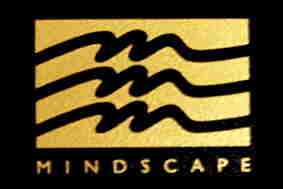

 |
 |
|
This is a velocity sensitive MIDI keyboard with sample based sounds, that originally came with a sustain pedal (of foam rubber?) and a complex and versatile piano teaching software.
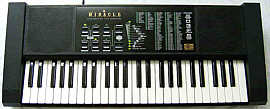 |
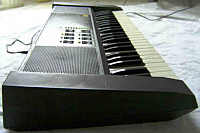 |
There is already plenty of info about this thing available on the internet and my specimen is missing the software package and pedal, thus I only write here a few words about the keyboard itself because it is not so well documented yet. Basically it is a normal velocity sensitive fullsize keyboard with MIDI in/ out and a sound bank with 128 built-in preset sounds (including various drum kits and effect sound sets), thus it also works well without the software package. The only main difference to an average modern MIDI keyboards is that it has no built-in rhythms, no pitch/ modulation wheels and that its 128 sound bank is not based on the General MIDI standard. The latter makes it particularly interesting because its sound bank this way contains a lot of all new and partly bizarre non-GM preset sounds.
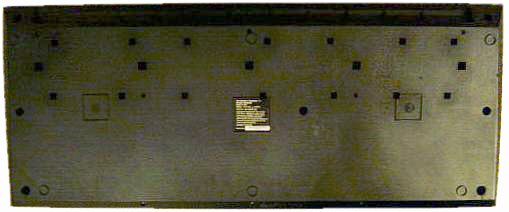 |
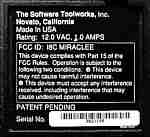 |
 Beside MIDI jacks there is a special serial "Miracle port" connector, that
was apparently used for PC serial port and game console versions.
Beside MIDI jacks there is a special serial "Miracle port" connector, that
was apparently used for PC serial port and game console versions. |
 |
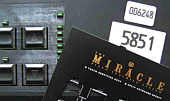 |
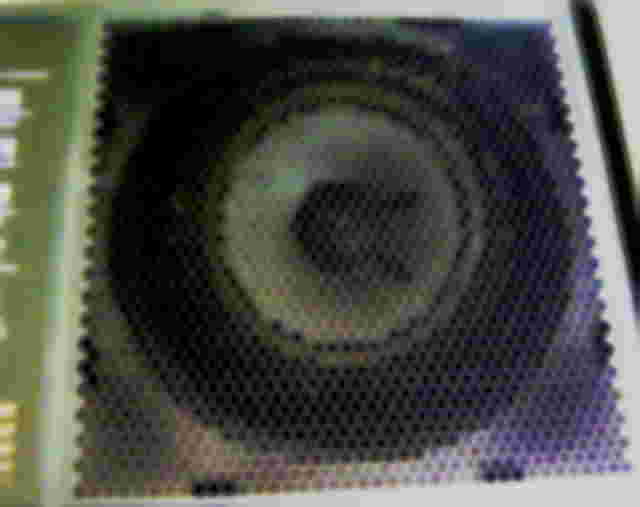 The
speakers are much smaller than their grills. (This photo was digitally
processed to show it clearer.) The
speakers are much smaller than their grills. (This photo was digitally
processed to show it clearer.) |
The sounds are based on samples of medium to quite high resolution. If you expect them to sound static and rather cold than you are completely right, because this thing fulfils all the well known prejudices against sample based sound bank instruments. The Miracle Piano can not do well warm and analogue timbres despite one preset sound (a lead synth with chorus) even has the naughty name "Moog". But at least some bright brass synth timbres resemble classic analogue sounds. The keyboard velocity only changes the volume of the preset sounds but never modifies the timbre in any way (despite various sounds seem to consist of 2 layered samples) and also the note duration does not change the timbre, which makes the sound quite static. The keyboard velocity behaves exponential, which makes it difficult to play medium loud notes on sustaining sounds because soft and medium strong key presses play rather quiet while slightly harder presses already rise the volume over- proportionally loud. (An acoustic piano behaves more linear.) Another annoying flaw is that the envelope of decaying sounds (like pianos or guitar) stops too soon instead of slowly fading silent. The envelopes also have a little zipper noise. Some sounds (e.g. ensemble sounds like "horns", "trumpets", "thrombones") contain a stereo chorus effect that halves the polyphony; others include a mono chorus. The chorus usually sounds a little gritty because it apparently switches the timbre (using a filter??, or phasing??) stepwise with about 4Hz (similarly like ensembles sounds on e.g. Fujitone 6A or Yamaha PSS-390). The acoustic pianos sound quite realistic; they seems to be a multi sample with 4 split points while most other sounds have none. Especially brass and bowed string timbres are realistic, but with such sustaining sounds the velocity sensitive keyboard is rather confusing because the final volume of louder growing timbres is badly controllable since the keyboard is not pressure sensitive and thus the volume of a long note can not be changed without re- playing the note because the keyboard only senses the pressure at the beginning of a note. Only a few organ and harpsichord presets have velocity disabled. The 3 human voices (called "Vox" 1..3) have a quite low resolution and the gritty chorus effect. Otherwise there is an "organ" timbre which sounds much like a higher resolution "ah" voice. The sitar is mislabelled(?) "Syntar". The "Log Drums" resembles rather a harp (at least with high notes) and the "Steel Drums" sounds nicely unrealistic (gong- like?) with a bassy bass range. Various instrument sounds exist in versions with and without sustain.
But the most interesting part of the sound bank are not the natural
instrument samples (those you find nowadays on any General MIDI sound source)
but the lots of bizarre effect sounds. E.g. there are 3 drum kits (high
resolution samples; each sample is repeated on a few adjacent keys with
different pitch) and 2 effect kits those include a lot of weird tekkno
and hiphop noises like record scratches, thunder, car skidding and burp-
like stuff. Also great are the 15 "Synth Pad" sounds although many of them
have a percussive decay envelope (like a piano) and thus genuinely are
rather lead voice than pad sounds. They include typical bright digital
synth timbres and many of them have a bizarre buzzy purring bass range
that resembles the sound of a ruler rattling against a desktop rim. Likely
their waveforms are simply intentionally "wrongly" looped versions of the
instrument samples; some sound woody while others rather resemble a looped
lion roar sample or the like. But some of these sounds contain a long release
phase that takes much polyphony and causes annoying random popping glitches
during polyphonic play; apparently such sounds tend to overload the instrument's
CPU or make it run out of polyphony, possibly also because the purring
and chorus may be generated by a realtime algorithm that draws additional
CPU load. Some "Synth Pad" sounds ring with a switched stereo panning effect.
Another bizarre timbre is "Frogs/ Ducks", which is a thin and very dry
chirping duck squawk that was possibly inspired by the "frog" sound of
early Casio Consonant Vowel synthesis instruments (also see Casio
MT-60 and CT-410V) although
this one is definitely a sample (it gets shorter at higher octaves). Also
many of the synth sounds (e.g. synth brass stuff) sound and behave very
much like historical Consonant Vowel timbres and thus are likely made like
these from 2 static waveforms with independent volume envelopes. Generally
various timbres somewhat remind to the wavetable based Casio
SA
series keyboards although the latter do far more complex algorithmic
tricks in their preset sound while the Miracle Piano employs only
some switched ringing, chorus and panning effects.
More info about this instrument can be found on the internet. Even the original manual can be downloaded somewhere.
Wanted: I am searching for
the historical piano teaching software (PC Windows or Amiga version) that
belongs to the instrument, because without it the thing is only 1/3 the
fun. I already downloaded the ROM dumps of the NES and Megadrive/
Genesis
cartridge versions, but since game console emulators support no MIDI connection,
they don't work with the keyboard anyway. (I got a copy of the DOS software
but haven't tried it yet.)
| removal of these screws voids warranty... | ||
 |
||
|
|